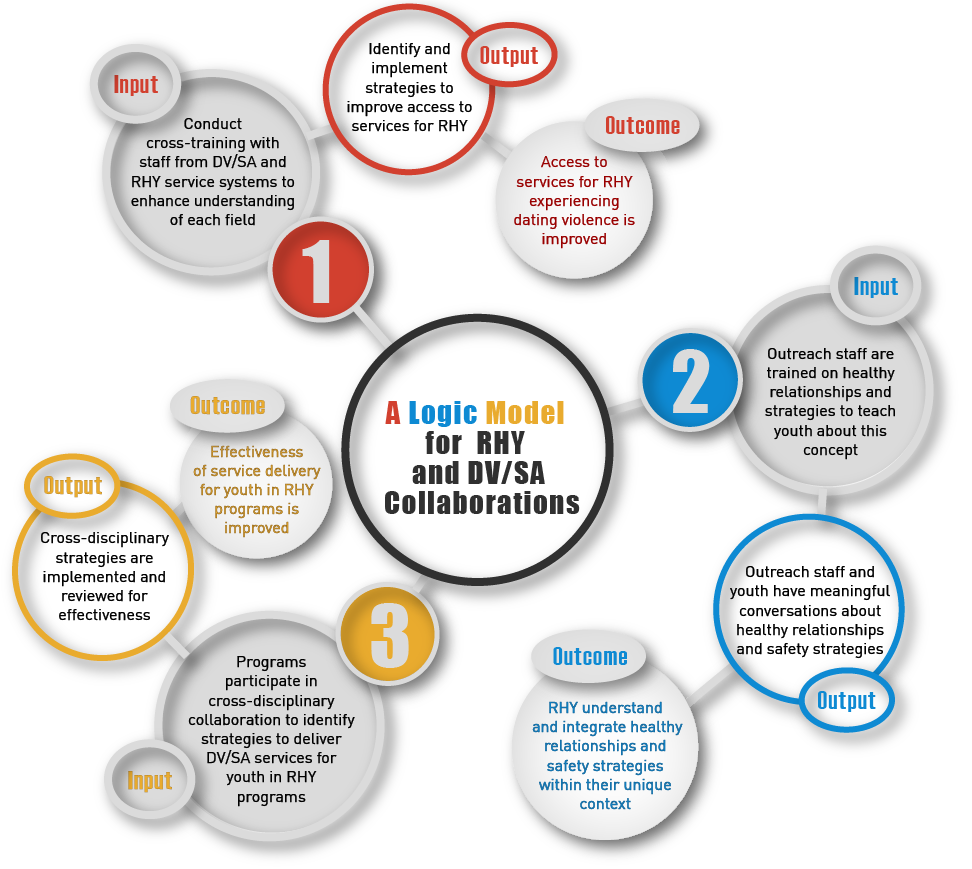Why Collaborate? A Logic Model
Providers of outreach, prevention, safe havens and counseling services for runaway and homeless youth are keenly aware that many of the young people who seek their services have witnessed domestic violence and/or have been victims of relationship violence, and/or child maltreatment or neglect in their homes.
The Data
Adolescents who have run away from home, are homeless, or are unstably housed experience substantially higher rates of dating violence and victimization than their stably housed peers.1, 2, 3 There are several factors contributing to the high rates of domestic violence and victimization within the runaway and homeless youth population including limited access to resources and increased exposure to street culture.4, 5 In addition, homeless youth may engage in subsistence strategies that place them at greater risk for partner violence, such as survival sex, that increases their visibility and proximity to potential perpetrators.
The Service Gaps
In many communities, there is a lack of interaction between RHY and DV/SA programs that creates a gap in information and services between the two. According to a 2007 multi-state survey conducted by the Mid-Atlantic Network of Family and Youth (MANY) and the Pennsylvania Coalition Against Domestic Violence (PCADV):
-
Over 40% of DV/SA service providers had no knowledge of the RHY programs in their area or the services they provided.
-
Less than 50% of the DV/SA surveyed were familiar with or comfortable providing services to runaway or homeless youth.
- Few RHY transitional shelter providers reported screening for intimate partner violence and victimization during intake and even fewer felt that they were providing effective services to address relationship violence and abuse.
Strengthening response:
By sharing our knowledge and teaching one another about the populations served by each community, outreach outcomes and service provision to those in need can be greatly enhanced. When the two systems are better linked and formalized mechanisms for referrals, staff training, and program impact are developed, the community “safety net” will be stronger and more accessible to youth in need of protection and support.
A Logic Model for RHY and DV/SA Collaborations
2. Whitbeck, L.B. & Hoyt, D.R. (1999). Nowhere to grow: Homeless & runaway adolescents & their families. Hawthorne, NY: Aldine de Gruyter.
3. Chen, X., Thrane, L., Whitbeck, L.B., Johnson, K.D., Hoyt, D.R. (2007). Onset of conduct disorder, use of delinquent subsistence strategies, & street victimization among homeless & runaway adolescents in the Midwest. Journal of Interpersonal Violence, 22, 1156-1183.
4. Tyler, K.A., Hoyt, L.B., Whitbeck, L.B. & Cauce, A.M. (2001). The impact of childhood sexual abuse on later sexual victimization among runaway youth. Journal of Research on Adolescence, 11, 151-176.
5. Whitbeck, L.B. & Hoyt, D.R. (1999). Nowhere to grow: Homeless & runaway adolescents & their families. Hawthorne, NY: Aldine de Gruyter.








